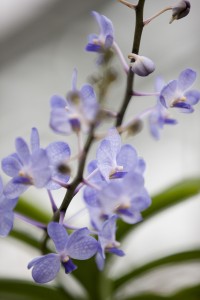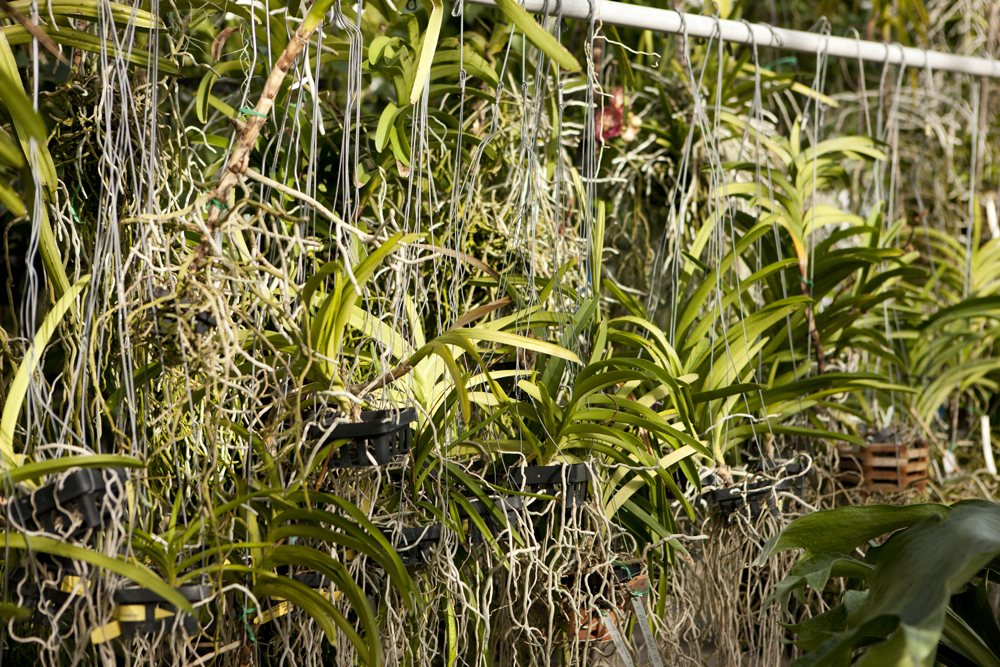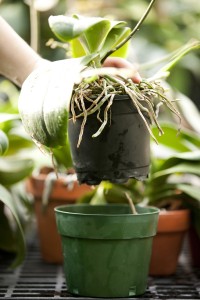New Heights for Orchids
Posted in Horticulture on March 4 2015, by Sonia Uyterhoeven
Sonia Uyterhoeven is NYBG‘s Gardener for Public Education.
 Most of us grow our plants in soil—we fuss over potting mixes for containers and we amend our planting beds with leaf mould or compost. For those of us who don’t like to get our hands dirty, there is an alternative. Members of the Orchidaceae family love to show off their roots, and many of them were destined to climb. Some 70% of all orchids, in fact, are epiphytic.
Most of us grow our plants in soil—we fuss over potting mixes for containers and we amend our planting beds with leaf mould or compost. For those of us who don’t like to get our hands dirty, there is an alternative. Members of the Orchidaceae family love to show off their roots, and many of them were destined to climb. Some 70% of all orchids, in fact, are epiphytic.
Orchids that dangle in the air—sometimes known colloquially as air plants—are classified as epiphytes. Epi means “on top,” and phyte means “plant”—essentially adding up to a plant that grows on top of another plant. The relation an epiphyte has with the host is not parasitic (where it is harming the host), nor is it symbiotic/mutualistic (where both parties benefit, but rather commensalistic (when one benefits and the other is neutral). The term commensalism is derived from the Latin for “sharing a table.”
Like anything in life, adaptation to an aerial environment has its pros and cons. Plants grow in the upper echelons of the forest canopy in order to receive better light, a habit that also protects them from herbivores that roam the forest floor.
While the appeal for new accommodations with a spectacular view is enticing, the cons of co-habitation up in the forest canopy are significant. Orchids need to find a way to attach themselves to their obliging hosts. No longer with their roots firmly planted in the soil, they not only need to find a means of support but also ways to effectively take up moisture and nutrients.
Epiphytes are a common phenomenon in the tropics. The plants’ adaptation to climbing is well-suited to the humid environment of tropical forests. Tropical epiphytes obtain water and nutrients from the dust and moisture in the air and from dampness and debris on the surface of the host. Some of the roots of epiphytic orchids wrap themselves around their host, while others dangle freely in search of moisture and nutrients.
Orchids have what is called velamen—a thick, silvery-white coating—covering their roots. The velamen tissues are in fact dead—they are filled with air, which gives them their grayish color. Botanists believe that this layer is present to protect the roots from damage and to help prevent water loss. Some scientists think that the velamen coating acts like blotting paper, absorbing moisture from the surrounding environment.

Epiphytic orchids also have other adaptations that help them survive in their unique environment. Many of them have thick, waxy, or leathery leaves. Some are slender and curl up on themselves, reducing their surface area and thus restricting water loss. Others look almost like succulents, with swollen leaves and pseudobulbs that store water for periods of hardship.
Some epiphytic orchids have a special adaptation called CAM photosynthesis (Crassulacean Acid Metabolism) to help them survive their harsh environment. This is common among plants found in arid conditions.
Most plants open the stomata on their leaves (pores used for gas exchange) during the day to take in carbon dioxide for photosynthesis. When the stoma opens during a hot day, water escapes and evaporates through a process called transpiration (like sweating). CAM plants keep their stomata shut during the day to reduce water loss and instead open them at night to collect carbon dioxide. The carbon dioxide is then stored as an acid (hence the name) and used for photosynthesis during the day.
Many botanists postulate that a large number of epiphytes did not evolve from plants that inhabited dark forest floors. They believe their ancestors were plants that lived in savannah grasslands near forest perimeters, plants that started to climb on the shoulders of their neighbors and eventually hoisted themselves up into a new niche. Adaptive features such as CAM photosynthesis and the morphology of their leaves led botanists to this hypothesis.

For homeowners, the morphology of the orchid gives important clues to their needs. Thick, leathery leaves mean the orchid will enjoy good sun. Conversely, thin leaves generally mean that the orchid needs to be protected from strong sunlight.
Silvery roots covered in velamen will happily crawl out of their pots and expose themselves to the air. Since the humidity in your home does not compare with that of a tropical rain forest, make sure to keep these roots hydrated and healthy by wetting them—humidifiers work, misting is labor-intensive but effective, and an occasional dunking never hurts.
Pseudobulbs (the swollen part of stems) are an adaptation to help orchids retain water to carry them through dry spells. Water these orchids heavily, but then allow them to approach dryness so that they can replicate the conditions they encounter in the wild. Do not over-water these plants, however—you will only rot their roots.
For more information on orchid care, or to find answers to your questions on these lovely houseguests, stop by my home gardening demonstrations taking place each weekend during The Orchid Show.

